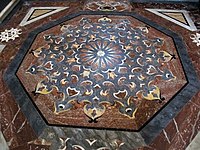Certosa di San Martino
| Certosa di San Martino | |
|---|---|
| Patronage : | Maria , St. Martin of Tours |
| Order : | Carthusian |
| Address: | Naples |
Coordinates: 40 ° 50 ′ 36.3 " N , 14 ° 14 ′ 28" E
The Certosa di San Martino ( Charterhouse of San Martino ) is a baroque monastery complex with a church in Naples . It stands on the Vomero hill below the Sant'Elmo fortress . It has been a National Monument of Italy since 1866 and its vineyard since 2010 .
The Museo nazionale di San Martino is also located in the former monastery building .
history
The Certosa di San Martino was the second Carthusian monastery in southern Italy after San Lorenzo a Padula . It was founded by Duke Charles of Calabria . The church was consecrated on February 26, 1325 to the Virgin Mary, St. Martin and all saints. The eponymous Carthusians moved in in 1337. Only a few altars have survived from the former Gothic building, which are now in the museum in the prior's apartment .
At the end of the 16th century, a phase of intensive renovation of the entire structure began under Prior Severo Turboli. The Florentine Giovanni Antonio Dosio was initially appointed as the architect in 1591 , who worked on the new building of the Charterhouse until his death in 1609. He was followed by Giovan Giacomo Conforto and from 1623 to 1656 Cosimo Fanzago , who u. a. gave the church its incomparable character with a precious polychrome marble decoration. The decoration of the church and its ancillary rooms such as the sacristy and treasury continued into the 18th century, and the most important artists of their time were involved in it: sculptors such as Michelangelo Naccherino , Pietro Bernini , Lorenzo and Domenico Antonio Vaccaro and Giuseppe Sanmartino created the Sculpture and marble decor. The ceiling vaults were painted by Cavalier d'Arpino and his brother Bernardino Cesari , Belisario Corenzio , Giovanni Lanfranco , Paolo Finoglia and Luca Giordano . The main altar was designed by Francesco Solimena , among the altarpieces are works by Jusepe de Ribera , Battistello Caracciolo and Massimo Stanzione u. a.
After the brief interlude of the republic in 1799 and again under French rule in 1806, the Carthusian monks were expelled. The monastery building became a nursing home for disabled soldiers.
In 1866, the Certosa finally came into the hands of the state and has housed the Museo nazionale di San Martino since 1867 .
particularities
The Certosa is not only one of the most remarkable examples of the Neapolitan Baroque but also one of the most important Baroque total works of art, in which numerous important artists, architects, sculptors and painters participated from the end of the 16th century. Above all, it is considered to be one of the masterpieces by Cosimo Fanzago, who was responsible for large parts of the truly spectacular and ornate marble decoration in the church; this is one of the most important that was ever created in the field of pietra dura encrustation. Also worth seeing are the sacristy, the chapter house and other ancillary rooms, as well as the famous cloister with the monks' cemetery, which is also a work of Fanzago.
The Museum of San Martino in the former rooms of the monastery is one of the most important in Naples and not only houses the remains and altars of the former Gothic furnishings of the monastery, but also an important collection of pictures and other objects of art and the history of Naples. The crib collection is considered the most complete and important collection of its kind in Italy. a. Nativity figures by Giuseppe Sanmartino from the 18th century.
The location above Naples, which offers wonderful views of the Gulf of Naples and Mount Vesuvius , contributes to the unique beauty of the entire complex .
Ceiling frescoes by Giovanni Lanfranco in the nave
Ceiling frescoes by Cavalier d'Arpino and his brother Bernardino Cesari in the choir
Church floor with baroque opus sectile
Passage between chapter house and parlatoio , with ceiling frescoes by Bernardino Cesari (1593)
Luca Giordano : ceiling fresco Triumph of Judith in the treasure room
Busts of Nicolò Albergati (left) and Saint Martin (right) by Cosimo Fanzago and Domenico Antonio Vaccaro , cloister of the Certosa di San Martino, Naples
literature
- La Certosa e il Museo di San Martino , ed. v. Ministero per i Beni e le Attività Culturali, Electa Napoli, 2002.
Web links
Individual evidence
- ^ Napoli, la Vigna di San Martino diventa monumento nazionale
- ^ La Certosa e il Museo di San Martino , ed. v. Ministero per i Beni e le Attività Culturali, Electa Napoli, Naples 2002, p. 11
- ↑ La Certosa e il Museo di San Martino , ..., Naples 2002, p. 14
- ↑ La Certosa e il Museo di San Martino , ..., Naples 2002, pp. 14-15
- ↑ a b c d La Certosa e il Museo di San Martino , ..., Naples 2002, p. 15
- ↑ a b c La Certosa e il Museo di San Martino , ..., Naples 2002, p. 18
- ↑ cf. Italian it: Liquidazione dell'asse ecclesiastico
















